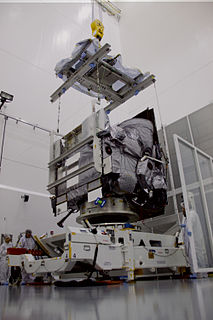 W
WEWS-G1 is a weather satellite of the U.S. Space Force, formerly GOES-13 and part of the National Oceanic and Atmospheric Administration's Geostationary Operational Environmental Satellite system. On 14 April 2010, GOES-13 became the operational weather satellite for GOES-East. It was replaced by GOES-16 on 18 December 2017 and on 8 January 2018 its instruments were shut off and it began its three-week drift to an on-orbit storage location at 60.0° West longitude, arriving on 31 January 2018. It remained there as a backup satellite in case one of the operational GOES satellites had a problem until early July 2019, when it started to drift westward and was being transferred to the U.S. Air Force, and then the U.S. Space Force.
 W
WGOES-14, known as GOES-O prior to reaching its operational orbit, is an American weather satellite, which is part of the US National Oceanic and Atmospheric Administration (NOAA)'s Geostationary Operational Environmental Satellite (GOES) system. The spacecraft was built by Boeing and is based on the BSS-601 bus. It is the second of three GOES satellites to use the BSS-601 bus, after GOES-13, which was launched in May 2006.
 W
WGOES-15, previously known as GOES-P, is an American weather satellite, which forms part of the Geostationary Operational Environmental Satellite (GOES) system operated by the U.S. National Oceanic and Atmospheric Administration. The spacecraft was constructed by Boeing, and is the last of three GOES satellites to be based on the BSS-601 bus. It was launched in 2010, while the other BSS-601 GOES satellites -- GOES-13 and GOES-14—were launched in May 2006 and June 2009 respectively. It was the sixteenth GOES satellite to be launched.
 W
WMEASAT-3 is a Malaysian communications satellite which was successfully launched on 11 December 2006 from the Baikonur Cosmodrome in Kazakhstan.
 W
WTDRS-8, known before launch as TDRS-H, is an American communications satellite, of second generation, which is operated by NASA as part of the Tracking and Data Relay Satellite System. It was constructed by Boeing is based on the BSS-601 satellite bus.
 W
WTDRS-9, known before launch as TDRS-I, is an American communications satellite which is operated by NASA as part of the Tracking and Data Relay Satellite System. It was constructed by the Boeing Satellite Development Center, formerly Hughes Space and Communications, and is based on the BSS-601 satellite bus. It was the second Advanced TDRS, or second-generation Tracking and Data Relay Satellite, to be launched.
 W
WTDRS-10, known before launch as TDRS-J, is an American communications satellite which is operated by NASA as part of the Tracking and Data Relay Satellite System. It was constructed by the Boeing Satellite Development Center, formerly Hughes Space and Communications, and is based on the BSS-601 satellite bus. It was the third and final Advanced TDRS, or second-generation Tracking and Data Relay Satellite, to be launched.
 W
WTDRS-11, known before launch as TDRS-K, is an American communications satellite which is operated by NASA as part of the Tracking and Data Relay Satellite System. The eleventh Tracking and Data Relay Satellite is the first third-generation spacecraft.
 W
WUltra High Frequency Follow-On (UFO) satellite system is a United States Department of Defense (DoD) program sponsored and operated by the United States Navy to provide communications for airborne, ship, submarine and ground forces. The UFO constellation replaced the U.S. DoD Fleet Satellite Communications System (FLTSATCOM) constellation and consisted of eleven satellites. The ground terminal segment consists of equipment and resident personnel at existing satellite communication stations. The satellites are controlled by the Naval Satellite Operations Center (NAVSOC) located at the Naval Base Ventura County, Point Mugu, California.